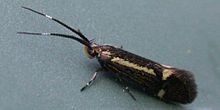| Esperia sulphurella | |
|---|---|

| |
| Scientific classification | |
| Domain: | Eukaryota |
| Kingdom: | Animalia |
| Phylum: | Arthropoda |
| Class: | Insecta |
| Order: | Lepidoptera |
| Family: | Oecophoridae |
| Genus: | Esperia |
| Species: | E. sulphurella |
| Binomial name | |
| Esperia sulphurella (Fabricius, 1775) | |
| Synonyms | |
|
Esperia aucta (Krausse, 1915) | |
Esperia sulphurella, also known as the sulphur tubic, is a species of gelechioid moth in the family Oecophoridae. It is native to Europe, but has been introduced in California.

Adults have a body length of 6–8 millimetres (0.24–0.31 in), and its wingspan is 12–16 millimetres (0.47–0.63 in). The wingspan is between 12 and 16 millimeters. They have a dark brown ground colour. The forewing has a pale yellow marking. The predominantly pale yellow hind wings are dark brown at the tips. At about two-thirds of the length of the antennae, the antennae have a white band.
They are on wing in spring.
The larvae are black and feed on dead wood.
Taxonomy
E. sulphurella was first described scientifically by J.C. Fabricius in 1775. Subsequently, the same scientific name was used for several other moths, creating a number of junior homonyms that are all invalid. These include:
- T. sulphurella of Fabricius (1777) is Oecophora bractella
- T. sulphurella of Hübner (1793) is Ypsolophus sulphurella
- T. sulphurella of Haworth (1829) is Povolnya leucapennella
References
- ^ Will, Kip; Gross, Joyce; Rubinoff, Daniel; Powell, Jerry A. (2020). Field Guide to California Insects. Oakland, California: University of California Press. pp. 353–354. ISBN 9780520288744.
External links
| Taxon identifiers | |
|---|---|
| Esperia sulphurella |
|
This article on a moth of the family Oecophoridae is a stub. You can help Misplaced Pages by expanding it. |